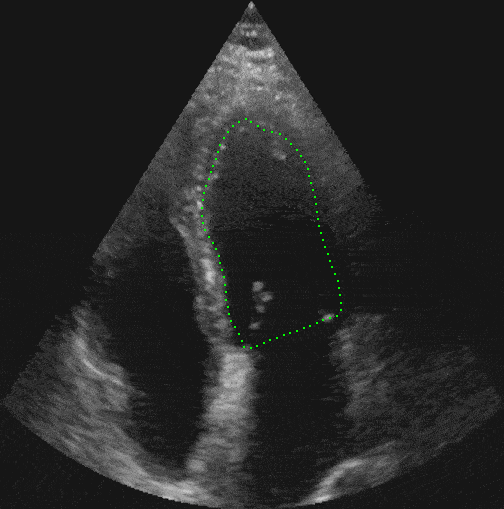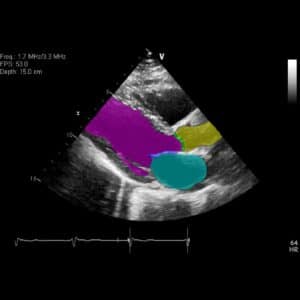The volume of the heart’s ventricles at the end diastole and systole serve as prognostic indicators for arrhythmia, ventricular fibrillation and the risk for cardiac arrest. Extracting information regarding the dynamics of ventricles contraction is therefore important for the diagnosis of these pathologies. Ultrasound technology offers a straightforward view of ventricles dynamics, so that cardiovascular ultrasound devices are common in clinical practice for initial examination and quick prognosis. The image obtained from ultrasound is generated by collecting the reflected sound waves off of tissues into an intensity map. Advances in image ultrasound reconstruction allows better visualization of tissues using nondestructive frequencies; however ultrasound images remain noisy and their interpretation requires an experienced physician.
.
Automated cardiovascular ultrasound software
RSIP Vision has constructed an automated cardiovascular ultrasound procedure to track the ventricles throughout the heart’s cycle. Ultrasound recording in a 4-chamber view over a period of several heart cycles allows RSIP Vision’s algorithm to track the contraction and report frequencies and volume, thus serving as a quantitative tool to assist in delivering accurate prognosis.
Tracking the edges of the left and right ventricles in a noisy ultrasound is not a trivial task. In addition to the noise, the deformable nature of the heart, the translation caused by breathing and the operator moving the ultrasound device, all add to the complication. RSIP Vision’s cardiovascular ultrasound software compensates for these types of involuntary motion and successfully tracks the ventricle walls.
.
Ultrasound software advanced techniques
The technique we chose to track deformable objects is active contour models (snakes). The active contours tend to cling on the ventricle walls during contraction by minimizing a tailor made energy functional, which takes its image specific gradient and intensity maps as input. Successful tracking allows us to segment the ventricles and therefore report on the dynamics of the volume as it changes throughout the heart cycle. Embedding our algorithm in an ultrasound station, quantitative measure can be obtained in real-time.
RSIP Vision has been developing customized image processing and computer vision software and solutions for cardiology and other medical fields for over 2 decades. You are invited to contact our engineering team to learn how RSIP Vision can help you achieve your R&D goals.


 Ultrasound
Ultrasound